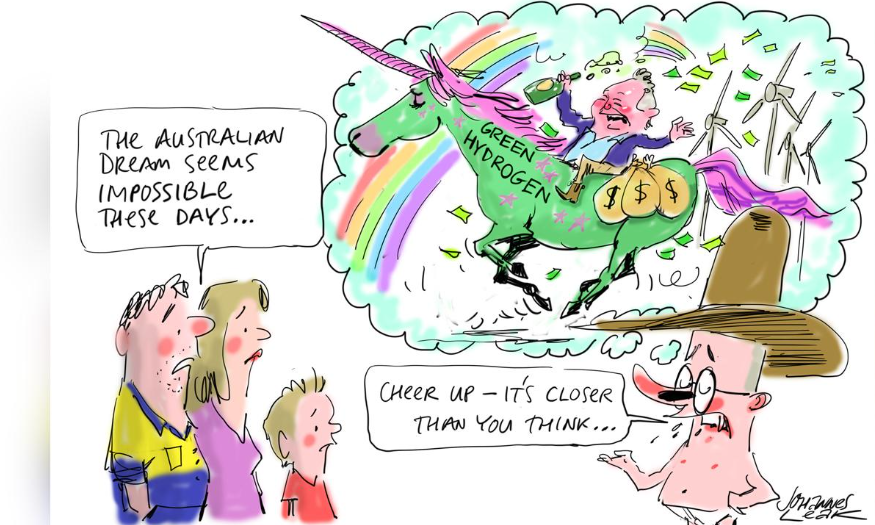At the end of every massive wind and solar subsidy rainbow, you’ll find a rent-seeking, crony capitalist salivating at the opportunity to cash in, at your expense. They’re called ‘rent-seekers’ for good reason:
Rent-seeking is an economic concept that occurs when an entity seeks to gain wealth without any reciprocal contribution of productivity. An example of rent-seeking is when a company lobbies the government for grants, subsidies, or tariff protection. Rent-seeking comes in many forms from lobbying or donating funds.
Separating taxpayers and power consumers from their hard-earned is the name of the game.
And, in Australia, the game is greased heavily in favour of the crony capitalists, thanks to a bunch of socialists armed with arts degrees and driven by nothing but infantile ideology.
As Chris Kenny details below, the rent-seeking class have hit the jackpot with the Green/Labor Alliance which has conjured up a staggering range of schemes and scams designed to line the pockets of the superrich, at the expense of embattled taxpayers and power consumers.
Labor’s renewables folly superpowered by taxpayers
The Australian
Chris Kenny
18 May 2024
The night after the budget an ABC reporter stood outside Parliament House speaking credulously about Labor’s plan to turn Australia into a “renewable energy superpower”. No eyebrow was cocked, no “so-called” inserted and no scepticism betrayed.
In an age when politicians have revealed themselves to be as disingenuous and cynical as ever, their prognostications on climate and energy are simply not questioned by large elements of media, academe and business. These are the same elements, presumably, that profit from the related hysteria, research grants and subsidies.
This unfolds while an energy-rich nation endures a self-made energy crisis. Australia’s natural endowment of cheap and plentiful energy has been sacrificed willingly, squandering industries, jobs, prosperity and security.
The truth is that in an area where we are constantly urged to “follow the science” there is an overwhelming tendency to avoid reality, along with all the applied sciences, from engineering and ecology to electrodynamics and economics.
In this year’s budget Anthony Albanese and Jim Chalmers have closed the circle on this nation’s grand energy self-harm, demonstrating the triumph of ideology over reality and virtue signalling over the national interest.
The country with the highest penetration of renewable energy in the world is Iceland, where hydro and geothermal electricity provide a mountainous and volcanically volatile country with plentiful power. Iceland is fortunate because it uses high amounts of electricity for industry and home heating at low costs with minimal carbon emissions. But have you ever heard anyone refer to Iceland as a superpower?
Australia, on the other hand, is blessed with internationally significant and globally envied deposits of exploitable coal, gas and uranium, and under Labor and the Greens we aspire to use none of these ourselves. We are an energy-rich nation (you might say an energy superpower) but we have deliberately consigned ourselves to domestic energy poverty.
The transparently transactional decision by the Prime Minister and the Treasurer to spend $3.5bn of taxpayers’ money funnelling $300 for every household and $325 for every small business to energy retailers so they can lower power bills for one year is the subsidy that closes the vicious circle of Labor’s virtue-signalling vandalism. Along with other governments, state and federal, Labor and Coalition, they have now conspired to subsidise all sanity out of what is laughingly called our national electricity market.
It began with a leg up for renewable energy, subsidising the installation of solar panels in homes and businesses, then mandates to effectively subsidise large-scale wind farms and solar factories, plus grants and loans for more of the same along with batteries and transmission lines.
Governments have pumped at least $20bn into this transition (there are so many subsidies, grants and schemes at so many levels that it is difficult to tally) and private investments have totalled up to 10 times that which, on current plans, will need to be replicated five or more times over – $1 trillion, all to be repaid with interest and profit by consumers.
The express aim of the subsidies has been to force coal-fired generation out of the system; and given the inflexibility of coal generation and the low cost of renewables when they are available, the strategy has worked. Coal cannot compete and tens of thousands of megawatts of coal-fired generating capacity has been retired with the rest scheduled to phase out across the next decade.
This has created only two problems, but they are major – high costs and unreliable supply. Power is more expensive than ever because when the sun is not shining or the wind is not blowing we are left to rely on whatever coal or gas-fired generation is available at whatever cost (up to the market ceiling).
Even then, and even with demand management (paying high-energy users to shut down), we do not have enough supply. After two consecutive mild summers, if we get a normal hot summer the NEM will face extreme supply challenges in February and March. The Australian Energy Market Operator repeatedly warns about this likelihood. (It is one reason I think Albanese might prefer to go to the polls this side of Christmas.)
Given the way subsidies have successfully forced out coal generation, the supply crunch has prompted state governments in Victoria and NSW to subsidise coal-fired generators to extend their operating lives. The same taxpayers who are paying subsidies to force coal out are paying subsidies to keep coal in.
And now, because of the unprecedented costs of all this madness, the federal government will subsidise all household power bills regardless of the need or wealth of the householders. State governments offer subsidies, too, including a $1000 pre-election hand-out in Queensland.
To be clear, we subsidise renewables to force coal out, subsidise coal to keep coal in, subsidise industry not to use power so we can reduce demand, and now subsidise all consumers to help them pay for the expensive power the subsidies have produced. And this is all done in the name of transitioning to renewables because they are the “cheapest form of energy” so we can become a “renewable energy superpower”.
By spending $3.5bn on these pre-election household and small business electricity bill rebates, Labor is effectively admitting its own energy failure. It promised to lower electricity bills by $275 a year but has seen them increase by at least double that.
Rather than implement policies that will lower electricity costs, Albanese and Chalmers use taxpayers’ money to artificially hold down power prices for one year. An election year.
Imagine if Labor were as ruthlessly transactional with generating electricity as it is in trying to maintain political power. Then perhaps the government would have kept more coal and gas-fired generation on stream to make sure our electricity was both affordable and reliable, and only forced it out when we had something reliable with which to replace it.
Never forget the driving force behind all this is the pretence that Australia can change the global climate. This is a scientific impossibility because our 1 per cent (and declining) share of global carbon dioxide emissions is being made up each year by increased emissions in China, India, Indonesia and elsewhere.
So determined are we to become a virtue-signalling super –sorry, a renewable energy superpower, that the same budget with rebates for all electricity consumers also allocated an additional $7bn for Snowy Hydro 2.0. This project was initially pledged by Malcolm Turnbull to be completed and operational this year at a cost of $2bn, but now it will cost at least $12bn plus up to $10bn in transmission links and will not open until the end of the decade.
The eye-watering cost of this renewable transition folly, likely to total more than $1000bn by the time it is done, exposes as risible the faux concerns from Labor and the Greens about the potential cost of nuclear energy. We could have a nuclear plant operating in every state already for the time and money we have blown on the “transition” so far – and we would have reliable electricity at a steady and affordable price without emissions or thousands of kilometres of extra transmission lines.
Climate Change and Energy Minister Chris Bowen’s budget announcements also included $30m on “consumer energy resources” for solar, batteries and electric vehicles, as well as $21m to “improve community engagement” over the solar factories, wind farms and transmission projects running into local opposition right across our continent. Under the Future Made in Australia boondoggle, Bowen promised $50m for so-called energy reforms and Labor has already allocated $1.5bn to subsidise the manufacturing of solar panels in the Hunter Valley in NSW.
Labor will pump another $5.1bn into the Australian Renewable Energy Agency and it will “supercharge” hydrogen production with a $6.7bn tax incentive and a $2bn hydrogen “headstart” program.
There is so much taxpayers’ money flowing in so many directions it is tempting to conclude that Labor is convinced that taxpayers’ money also is renewable – perhaps we will become a renewable money superpower.
Let us look at just one example of our grand self-delusion. Last year the federal government allocated $69.2m for a Central Queensland Hydrogen Hub at Gladstone as part of a $500m “investment” in such hubs around the country.
At a recent presentation Gladstone Port detailed the renewable energy investment that would be required for this project. It included “10,000 wind turbines” at an average size of 4.8MW. That is at least four times as many wind turbines around Gladstone than are currently installed across all of Australia.
This wind turbine installation would cost at least $40bn and would be paired with solar farm installations covering 2500sq km, or an area four times the size of Singapore. The port presentation also referred to 4000 transmission towers and boasted it would use enough steel to build the Storey Bridge 17 times over.
The scale and cost of these plans are vast – they are highly unlikely to ever eventuate. Yet we hear precious little questioning or scepticism, just more pleas for grants and more grand claims.
It reminds me of the multi-function polis in the 1980s, a Ponzi scheme of government industry grants, phantasmagorical political announcements, and grifters. Except this time there is a prize for every state, another renewable installation to ruin every vista and a hydrogen plant to float every boat.
For all the time we have spent and money we have wasted we could have built cleaner coal plants, a suite of nuclear reactors or at least arrays of gas peaking plants to firm up renewable supplies. But shoring up energy supplies has not been our No.1 priority; we have been more interested in climate gestures than practical outcomes.
A nation that deliberately weakens itself in this way, avoiding tough decisions and serious debates, cannot blame anyone else for its economic pain and vulnerability.
The Australian


